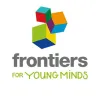
Digital Citizenship Week is October 20–24!
Join teachers worldwide to promote a healthy, positive approach to media and tech.
Take a look inside 6 images
Frontiers for Young Minds
Pros: Student-reviewed articles bring complex scientific concepts down to a relatable level.
Cons: Articles aren't filtered by grade level or standard, and can be lengthy, so teachers will have to vet them carefully.
Bottom Line: A well-designed site that keeps kids in mind without sacrificing educational integrity.
Exposing students to high-quality nonfiction can boost both reading skills and content knowledge, but it can be a challenge to find creative ways to get kids engaged in reading. With Frontiers for Young Minds, teachers can choose an article of the week for students to read and discuss in small groups. For example, students can read about coral reefs and discuss the challenges that climate change presents in preserving them. Then they can deliberate possible solutions and experience the process scientists go through when they're trying to solve problems that affect us all. For longer articles or collections, consider a jigsaw activity where students in groups read different sections of the same article or different articles in a collection and teach others what they learned. Encourage close reading by pulling out short excerpts or paragraphs and let students dig in, debate, or design an experiment to test the theories in the text.
For your especially passionate young scientists, direct them to the website's process to become a reviewer. Under the guidance of a Science Mentor, they might get the chance to review content for fellow science aficionados around the world.
Frontiers for Young Minds is a collaborative online science journal where kids review articles alongside adult scientists to convert complex scientific topics into kid-friendly language. Articles are published several times a week and focus on topics such as the science of dreams, astronomy, conservation, and tons of other topics. For teachers with more targeted learning goals, there are collections that revolve around specialties such as biodiversity, health, mathematics, and more.
Each article begins with an abstract and states the authors' and names and the ages of the young reviewers in the byline. Many of the articles are lengthy, but the content is broken up into subheadings. Plus, there's a short glossary at the end of each article where readers can see key terms defined. Links on the site provide opportunities to read articles in English or Hebrew as well as access to more Frontiers In journals; these tend to be geared more toward older students and researchers. Finally, for kids who might be interested in contributing to the site, there's an application process through which they can, with a sponsoring Science Mentor, apply to be reviewers.
The variety of topics and the pace at which they are published make Frontiers for Young Minds an attractive option for finding high-quality reading material for STEM classes. Collections provide opportunities to go in-depth on a topic while maintaining a fair amount of consistency in writing styles and format. Although the student reviewers range in age from 8 to 15 years old, the articles don't come with age, grade level, or standards-based recommendations. Teachers will need to spend some time reading articles in their entirety before assigning them to make sure they're a just-right fit for their students.
Depending on the topic, the vocabulary ranges from fairly easy to challenging; the glossaries underneath each article are helpful, but students will likely need additional teacher guidance for vocabulary and contextual knowledge. Also, the articles tend to be somewhat lengthy and don't offer text-to-speech options, so for struggling readers, this may present a challenge. Teachers will need to decide which content and topics align with their curricular goals, scaffold assignments accordingly, and provide supports where necessary.
















